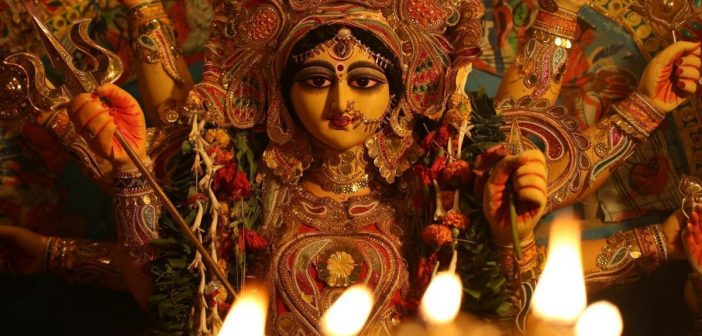As the Navaratri festival draws to a close today, India gears up for the grand celebration of Dussehra tomorrow. These back-to-back auspicious days symbolize the victory of good over evil and mark a time of immense cultural, spiritual, and social significance.
Navaratri: Nine Days of Divine Worship
Navaratri, meaning “nine nights,” is one of the most celebrated Hindu festivals. It is dedicated to the worship of Goddess Durga in her nine forms, each representing a different facet of feminine power or Shakti. The festival symbolizes Durga’s victory over the buffalo demon Mahishasura, representing the eternal battle between good and evil.
- The Nine Avatars of Durga: Each day of Navaratri is dedicated to a particular form of the goddess—starting with Shailaputri (daughter of the Himalayas) and ending with Siddhidatri (the granter of ultimate wisdom). This progression of the goddess forms shows the journey of spiritual awakening, from strength and determination to divine wisdom.
- Maha Navami (Final Day of Navaratri): Today, the last day of Navaratri, or Maha Navami, holds great importance. Many devotees observe fasting and offer special prayers to the goddess. In parts of India, particularly in the north, young girls are worshiped as Kanya (representing the goddess in her youthful form), and they are offered gifts and meals in a ritual known as Kanya Pujan.
In West Bengal, Durga Puja, which coincides with Navaratri, reaches its climax today, as elaborately decorated idols of Goddess Durga are taken in large processions for immersion into water bodies. This act symbolizes the departure of the goddess from her earthly home back to Mount Kailash, marking the end of festivities with a sense of farewell and renewal.
Dussehra: The Celebration of Victory
Following Navaratri is Dussehra or Vijayadashami, celebrated tomorrow, which honors the victory of Lord Rama over the demon king Ravana. This story from the Ramayana has deep roots in Indian mythology and culture, serving as a metaphor for the triumph of virtue and justice.
- Ravana Effigy Burning: The most iconic tradition associated with Dussehra is the burning of giant effigies of Ravana, his brother Kumbhkaran, and son Meghnad. These are set ablaze with fireworks in a dramatic spectacle, symbolizing the destruction of evil. This practice is most popular in North India, particularly in cities like Delhi, Varanasi, and Lucknow.
- The Theatrical Performance of Ram Leela: Across the country, Ram Leela—a traditional dramatization of the Ramayana—is performed in villages and cities. These performances, often involving entire communities, culminate in the defeat of Ravana on Dussehra, teaching moral lessons of righteousness, sacrifice, and loyalty.
Regional Variations of Dussehra
- Kullu Dussehra: In the Kullu Valley of Himachal Pradesh, Dussehra spans an entire week. The festival is unique in that there are no effigies burned. Instead, idols of local deities are carried in elaborate processions through the town, creating a vibrant cultural atmosphere.
- Mysuru Dussehra: In the southern city of Mysuru, Karnataka, Dussehra is celebrated with royal grandeur. The Mysuru Palace is lit up with thousands of lights, and a magnificent parade is organized, featuring an idol of Goddess Chamundeshwari atop a golden throne, accompanied by elephants, camels, and musicians.
- Bastar Dussehra: In Chhattisgarh, Dussehra takes on tribal hues. Celebrated for 75 days, it is a reflection of the tribal community’s unique traditions and rituals, where local deities are worshipped, and cultural performances take center stage.
The Spiritual Significance of Dussehra
Dussehra is not just a celebration of Lord Rama’s victory over Ravana, but also a broader symbol of moral and ethical victory. The festival encourages people to confront their own inner demons and overcome personal weaknesses. Just as Rama vanquished Ravana, individuals are urged to conquer negative traits such as anger, ego, and greed. It is a day to reaffirm faith in righteousness, truth, and integrity.
In Maharashtra and Karnataka, Dussehra is also associated with the worship of Saraswati, the goddess of knowledge. The day is considered an auspicious time to start new ventures, especially academic or professional pursuits, as it symbolizes the triumph of knowledge over ignorance.
The Economic and Social Impact
Navaratri and Dussehra are not just religious festivals; they are also times of significant economic activity. The festival season drives consumer spending, with people buying new clothes, vehicles, jewelry, and household items. Markets are decorated, and special discounts are offered, boosting the economy.
In addition, artisans and craftsmen across the country benefit greatly from these festivals. From idol makers in West Bengal to craftsmen creating the intricate pandals for Durga Puja, the festive season brings employment and economic vitality.
Conclusion: A Celebration of Victory and New Beginnings
As Navaratri ends today and Dussehra dawns tomorrow, India comes together to celebrate the timeless message of good triumphing over evil. These festivals, deeply embedded in the cultural fabric of the nation, are not just about grand rituals and traditions but also about introspection, renewal, and hope for the future.
From the fiery effigies of Ravana to the peaceful immersion of Durga idols, the cycle of destruction and creation is a reminder that every ending brings the promise of a new beginning. Navaratri and Dussehra remain powerful symbols of the moral victories that define human progress and the spiritual resilience that sustains it.






